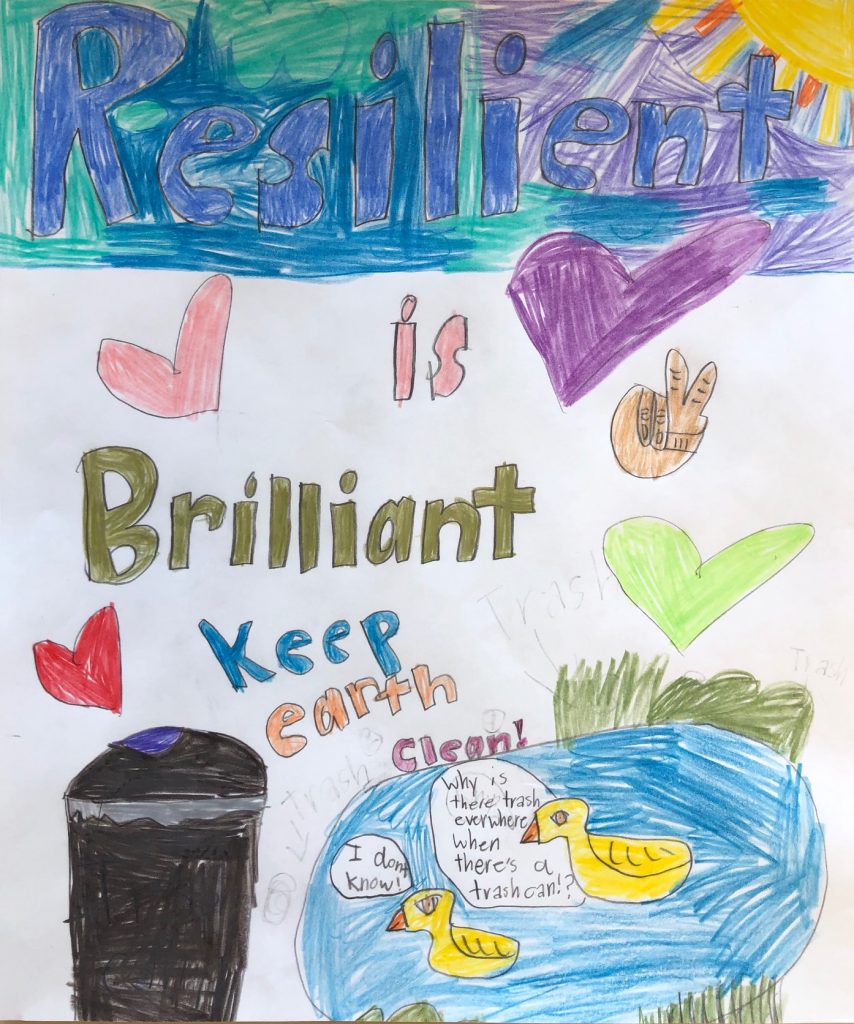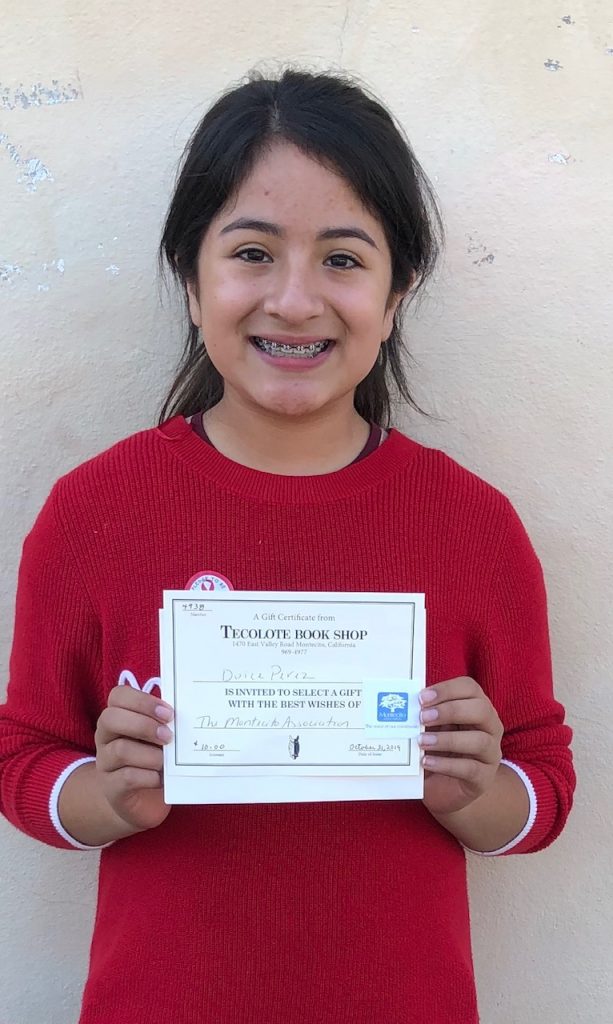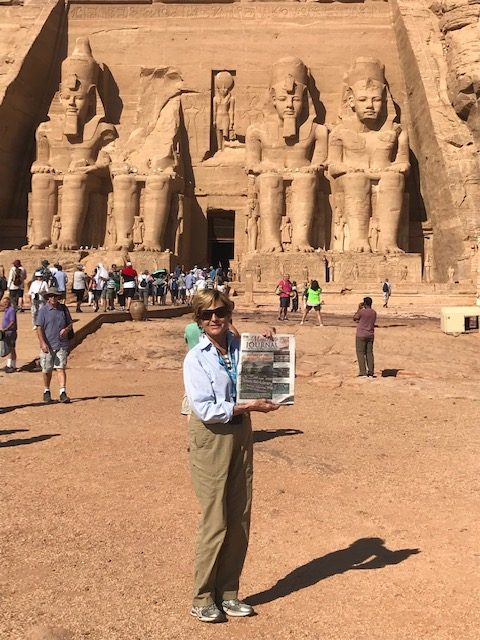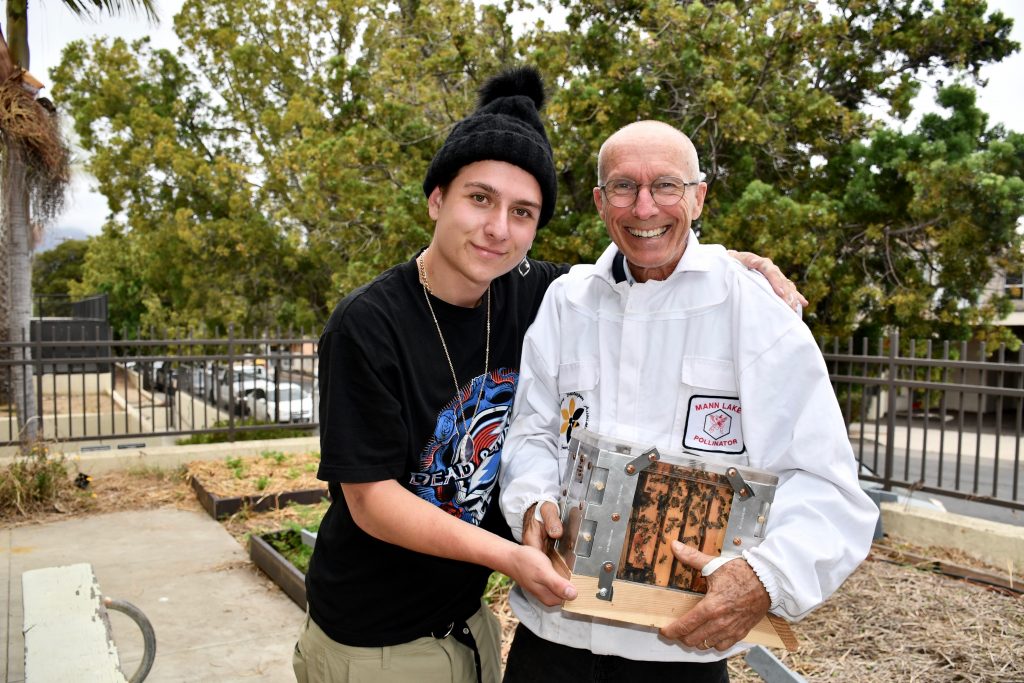Letters to the Editor
Firsts and Second
My students, Alessandra Robles took first prize, and Dulce Perez (not present for the award) second prize for our school (Our Lady of Mount Carmel) at this year’s Beautification Day art exhibit. We are very grateful to participate in this annual event which is a wonderful opportunity to showcase our school artists in the community.
For a separate talented Mount Carmel student notice, I just found out that Camille Martin, 4th grader, won her division in an art contest put on by the Santa Barbara Public Library. Her original art will be featured on a limited edition library card.
Many thanks, I am very grateful for these great kids to be recognized.
Jennifer Buur
Art Specialist
Our Lady of Mount Carmel School




The Cause of Conflict and the Solution
I read your Journal cover to cover – thank you for adding a breath of fresh air.
I had to share this with you all; too many of us are tired of the incessant conflicts and there is a solution:
For thousands of years, conflict has existed with all life forms. In the ocean, usually the bigger fish wins. In the forest, the taller tree grabs the light. In the wild roaming herds, often the dominant beast leads until age and agility forces a replacement with a younger, stronger specimen.
In the human race, brute force and size has been overshadowed by smarts of various descriptions to win over any competition, whether in sports, business, government, and life in general.
Before, conflict was a means to an end. Today conflict is the ends, and often mean. Left-Right. Red-Blue. White-Yellow-Black. Rich-Poor. Privileged-Forgotten. Fat-Thin. Old-Young. College-Street Smarts. As a dyslexic conservative, who likes the color blue, it is quite upsetting. But then again, today’s conflict is intended to upset, an ancient trick to create distraction, introversion and self-destruction.
So, let me make a truth perfectly clear.
All conflicts today are the result of an unseen third party, who is likely profiting from the resultant conflict. It is covert. It is deceiving. It is always based in ill-intention and extreme self-interest. It feeds both sides of the conflict with false and misleading data and unfortunately laughing all the way to the bank.
This same truth can be traced to why obviously simple issues like drought, the drug war, useful education that focuses on reading, writing, and arithmetic, wildfires, ample healthy food supplies, and the list goes on, cannot be solved, yes solved, inexpensively and thoroughly. Conflicts caused by unseen third parties intend to perpetuate these issues when entry level engineering and dedicated individuals left undistracted can create solutions.
So how do we as individuals, business owners, members of a community, leaders, address the conflict makers? As a start point, know that humans are basically good and seek to survive. Only a small percentage have slipped far away from a center of personal ethics. Next, know that most people can get along. This does not mean they have to agree but can be reminded of their inherent integrity to grant others the respect to be themselves.
Now, spotting those who are creating the conflict becomes more obvious. Investigation is critical. Keep pulling the strings until you find the sniveling runt at the bottom who has been instigating the conflict. They may drive a fancy car, have fancy degrees, be hiding behind some fame or fortune, but whatever the veneer, they will be like a mosquito, not to insult the little bug, but they’re blood suckers and cannot survive without sucking the life from those they embroil in their conflicts.
The next time you find yourself captured in an unresolving conflict, take a step back, re-assess your priorities, and know with certainty that all conflicts can be resolved unless some nasty individual is perpetuating the problem who has yet to be discovered. Pull back the veil and expose the source, then move on with your life and enjoy the freedom to know and use this truth.
Gillian Christie
CEO, Christie & Co.
Santa Barbara
Before The Flood
I played a few holes of golf with you and Tom Mielko at Birnam several years ago. I don’t know if you are still accepting travel photos of the Montecito Journal for publication, but this place is significant because the entire site was moved piece by piece, to allow for its former location to be flooded when they dammed the Nile.
Rosalind Amorteguy Fendon
Montecito
(Editor’s note: Well, heck yes, thank you. We are always pleased – and honored – when residents remember to take a copy of the Journal on their travels; next week, I’ll be featuring my own photo with the Journal in Paris! – J.B.)

Flawed Ideas
Elizabeth Warren is an intelligent person. She released her “How I will pay for everything” plans as U.S. President. I find it difficult to comprehend why she thinks her socialist plans make an ounce of financial (or common) sense.
In understandably limited writing space, it’s impossible to elaborate much. I encourage readers to do their own research. You have every right to disagree with me.
Medicare for all: We need to realize that Medicare doesn’t cover everything and supplemental insurance, offered by the private insurance companies her plan will eliminate, is a necessity for out-of-hospital expenses. Warren’s plans would cause doctors to leave the profession, medical facilities to downgrade or close entirely, and incredibly long waits for attention at any medical facility for any type of treatment. (Research the wait times for medical procedures in Canada, whose population is just 10% of the U.S.)
Warren’s tax plan (yes, everybody would pay higher taxes) punishing successful businesses and people would find them moving elsewhere (Mexico, China) and cause tremendous U.S. unemployment.
Warren would abolish fracking on her first day in office. When it comes to natural gas and oil, the U.S. – for the first time in history – is exporting more than it is importing. Do we really want to return to the days when we were dependent on unstable countries in the Middle East for energy? Warren’s Green New Deal ideas represent total disaster for the U.S. Economy. I’m sure Russia, China, and other less-than-friendly countries would love to see us implement them.
Until around 1980, Venezuela, with is vast oil reserves and stable economy, was the richest country in South America. It is now a socialist catastrophe.
Sanderson M. Smith, Ed.D.
Carpinteria
Nuclear Solution
I believe global warming is occurring! I believe billions of years of plant materials dying and falling into anaerobic conditions has led to much oil underground.
About 1895, burning of petroleum products became a method of powering things. Before that, whale oil was used. The combustion engine sparked the use of petroleum. This burning has increased to very high levels today. I estimate the planet’s ability to adapt to this massive excess of CO2 via new plant growth (if possible) is not adequate to keep up with these massive new supplies of carbon dioxide.
I have experienced climate change absolutely in my life. I grew up in La Cañada and there were two ski areas 45 minutes up Angeles Crest Highway. Mt. Waterman and Kratka Ridge. Ahhh, ski racing and being young… We always brought newspapers and dirty gloves for putting on chains on our car tires as that was sometimes required. The snowfall was such that at times the road was a slot with eight-foot tall walls of snow on the sides of the road.
It hardly even snows down there anymore.
I strongly believe we need to move to nuclear power. It has a horrible reputation, but truly is the answer. New designs make this power source very safe. If we had one small power plant each 100 miles along the California coast, the whole state could move to electricity for everything. Cars, houses, everything. The waste is not what it once was, and can be managed.
We have a problem and a very viable solution.
Imagine not burning petrol for everything except airplanes.
Charles McClure
Santa Barbara
(Editor’s note: Interesting idea, Mr. McClure, certainly better than shutting everything down; one thing though: 30,000 airplanes spewing contaminants into what looks like a thin layer of atmospheric protection every single day are probably more dangerous than any land-based pollution. Just saying… – J.B.)
No Nobel
I was a bit surprised to read in Mr. McLaughlin’s Letter to the Editor (“Montecito’s Nobel Winning Author,” MJ # 25/44) that the great German author Thomas Mann was “a previous Montecito resident.” I have no idea where that came from, but, having researched whether there was any Mann residency here when writing “Literary Santa Barbara” twenty years ago, I can report there was none.
He lived in L.A. during some of the 1940s, building a home in Pacific Palisades. But we shouldn’t despair: Montecito is not bereft of literary Nobel laureates, in fact there have been two, though not actual residents, but rather visitors. The first was the English novelist John Galsworthy, best known for The Forsythe Saga. He and his wife spent the winter months of 1912 and 1920 at the San Ysidro Ranch. He was not a Nobel laureate at that time; the honor would not be bestowed until 1932. The other writer was Sinclair Lewis, who also spent time at the Ranch, he in the late 1930s. He was a laureate at the time, having received the prize in 1930, a year before, who else…? Thomas Mann. But who knows, maybe that German fellow checked into the Ranch under an assumed name.
Steven Gilbar
Montecito
(Editor’s note: Readers should know that Mr. Gilbar is a resident historian, but Mr. McLaughlin usually gets it right, so I look forward to his explanation or corroboration – J.B.)
Medicare For All!
These nitwits that propose “Medicare for all” do not know what Medicare is. All Americans are forced to contribute to Medicare when they start to earn an income. Since President Johnson thrust it upon the American public in 1965, your contribution is taken out of your salary along with your Social Security and payroll taxes. You have no choice. It is the law. It is no insurance until you have paid into it for 40 years and then, when you turn 65 – if you live that long – Medicare pays part of your medical expenses, if any, and you keep on paying for it until you die. There is nothing free about Medicare and no one gets anything until they are 65. In the meantime, while you work, you have to buy personal insurance. Medicare is the worst insurance ever invented by liberals; it’s even worse than ObamaCare. Are these liberals idiots or what?
Justin M. Ruhge
Lompoc
(Editor’s note: Mr. Ruhge classifies himself as a “senior on Medicare” – J.B.)
The Power of One-on-One
Medicine and teaching might seem like very different occupations, but I know from experience that they have more in common than you’d expect. As a former chiropractor and a current high school teacher, I’ve learned that both patients and students are looking for a trusted advisor to help them on their path. Every patient and every student makes progress at their own pace, and each one has unique needs.
That’s why I’ve made it my mission to give my students at La Cuesta High School in Santa Barbara the same kind of one-on-one support and attention I gave my chiropractic patients. For the past two years, I’ve worked toward that mission with the help of Summit Learning, a research-based approach to teaching that’s designed to drive student engagement, meaningful learning, and strong student-teacher relationships. With Summit Learning, I’ve been able to get to know each of my students more deeply, diagnose where they need support and where they’re making good progress, and give them targeted guidance to help them succeed. This is especially important for students like mine, who are credit deficient.
Before our school joined the Summit Learning Program in 2017, I did my best to find ways to tailor the learning experience to each one of my students. I tried to sit down with each one, guide them through assignments, and encourage them to let me know when they were ready to be graded—because I knew every student learns at their own pace.
Now, because I can monitor student progress in real-time through an online tool, I am able to individualize learning even better in my classroom. I have regular one-on-one meetings with my students to help them set goals and to mentor them on ways they can achieve them. My students have access to different types of materials—from videos to articles to hands-on experiences—that help them learn in the ways they choose. They take assessments when they’re ready, and if they don’t pass, they return to the materials and then take the assessment again. This real, meaningful learning approach ensures that they learn the content, rather than just moving on without the knowledge they need.
With Summit Learning, students have the chance to learn through projects that reflect challenges they might face in the world around them. In my Biology classroom, I introduce the project by engaging students in a lesson on beekeeping and the demise of honey bees and Colony Collapse Disorder from the effects of the 4 P’s – Pesticides, Pests, Pathogens, and Poor Nutrition (drought). My students then learn more about ecosystems by becoming experts on a threatened ecosystem of their choice. The students gather and analyze information about their ecosystem to understand how it benefits humans, as well as the threats it faces. They develop and refine an action plan that they communicate to the public through a multimedia campaign. Through this experience, they develop skills like inquiry, analysis, synthesis, and communication—skills they’ll use throughout their lives.
Just as targeted treatments helped my chiropractic patients heal, this personalized approach to teaching has helped my students grow and achieve more. In the past two years that we’ve used Summit Learning at La Cuesta, I’ve seen students become more focused and engaged than ever. They’ve taken ownership of their learning and developed habits and mindsets that will help them succeed beyond high school. They’ve grown not just as students, but as well-rounded people who are ready for the future.
I’m excited to continue to use Summit Learning with my students this school year. I’m confident this approach will continue to transform my teaching for the better. And I know that with the right attention and support, my students—like my patients—can make great progress.
Dr. Paul Cronshaw
Montecito

The Big Con
After years of controversial Supreme Court decisions expanding the power of the federal government, we find ourselves in the year 2019 with absolutely no limitation whatsoever on what Uncle Sam can or cannot legislate in the areas of insurance and health care, two subjects that were historically left to the States. So here come the Democrat candidates for president offering their nationwide one-size-fits-all health programs that they know will make your life better. Many of them have adopted the phrase “Medicare for All” to describe their proposals. This is classic political mislabeling designed to deceive the voter. A better title would be “Unlimited Free Health Care for Everybody”
What Bernie Sanders and Elizabeth Warren are proposing, and what is the ultimate goal of all of the other candidates, is a sweeping takeover of all health care in the United States by the federal government. This is not Medicare as we know it. Established in 1965, Medicare is a government insurance program for seniors with participation by the private insurance sector and taxpayers. It functions much like an insurance company: It takes in funding from its insureds during their working years in an amount equal to 2.9% of their salary (up to 3.8% for higher income earners); and receives mandatory cash premiums from seniors when they enroll at the age of 65.
Medicare provides benefits to its insureds in amounts which are paid to medical facilities and health care providers who agree to accept such payments as total compensation for their services. Like insurance, Medicare has co-pays and deductibles for most claims for which amounts seniors can purchase supplemental or gap insurance coverage from private carriers to cover. And also like insurance, it has coverage exclusions (e.g. dental, vision, hearing, long term care, and myriad testing and medical procedures).
Contrary to what the average person under 65 might think, Medicare is not free to seniors. In addition to payroll withholding payments of 2.9% of their lifetime income, eligible seniors must pay a monthly premium to have Medicare Part B cover doctor bills and outpatient services. That premium starts at $135 per month per person and, depending upon income, can rise to $460 per month per person. For seniors who did not contribute to Medicare during working years for at least 40 quarters, they must opt into Medicare Part A (hospital care) for $437 per month. If a senior wants drug coverage, they must pay an average premium of $52 per month per person which, depending upon income, can go up to $132 per month per person. In addition, in order to avoid paying large deductibles, a great number of seniors purchase a private insurance policy to cover amounts Medicare will not pay. For a senior aged 72, the monthly premium for a quality supplemental plan is in the area of $230 per month per person.
Adding to the senior’s medical expenses, there are a growing number of doctors, principally general practitioners in larger cities, who have “opted out” of Medicare. These doctors don’t accept Medicare patients and charge non-Medicare rates for office visits. Many seniors choose to patronize such doctors either because they have been patients for a long time or they perceive and desire a difference in the quality of medical care. So contrary to having free health care, a senior on Medicare can pay anywhere from $417 per month to $1250 per month ($5000 to $15,000 per year) for health coverage, depending upon their retirement income. The amount could be even more if the senior elects to see a general practitioner who doesn’t accept Medicare patients.
With its costs, deductibles, and exclusions, whether fully understood by voters or not, Medicare has been around a long time and is generally viewed favorably by the public. Even though incoming revenue for Medicare is insufficient to cover the anticipated covered expenses, resulting in its certain bankruptcy in less than ten years, the program is still popular. Hence the Democrat candidates have incorporated the word “Medicare” in naming their plans to seize upon that goodwill and falsely describe their proposals for a total government takeover of all health care as “Medicare for All”.
Medicare is a funded (for the most part) national insurance plan, with active involvement of the government, the insurance industry, the medical service industry and the public; “Medicare for All” is a totally unfunded entitlement. Sanders and Warren are intentionally trying to deceive the electorate when they describe their plans as Medicare for All. What they want is to force everyone into a socialized national medical program in which the Federal Government would make every decision on every health issue.
Under their plan, it would be illegal for the private sector to have any involvement. It would be illegal for any type of private insurance, including any employee-sponsored insurance or reimbursement plan, to cover any medical expense. It would be illegal for a doctor or hospital to provide health services for any individual outside the federal program unless they forfeited any right to make any claim for any patient for one year.
Economically, the Medicare for All proposal is as far away from Medicare as one could get. Except for residents covered under Veterans Affairs and Indian Health Services, which are unexplainably excepted, every resident in the United States will automatically be covered, even those in the country illegally. No recipient will be required to pay anything in exchange for full benefits.
Workers would still pay Medicare withholdings at today’s rates but those amounts aren’t even enough to cover seniors under the current Medicare program. There would be no premiums, no deductibles, no co-pays, no contributions by patients whatsoever. The Medicare for All proposals provide for no additional incoming dollars, so the total additional burden will need to be financed by increased taxes. Counterpoised with this total absence of additional funding are the unlimited medical expenses that will be covered in full, including vision, hearing, dental, rehabilitation, travel, long-term care, and reproductive care (including abortion on demand).
This is different than the National Health Care systems in other countries. What Medicare for All will be for health care is what the U.S. Post Office is for mail delivery, but with the additional provisos that there will be no charge for postage and no private company (FedEx, DCL, UPS) will be allowed to compete. It will be like AMTRAK with no charge for tickets, no classes of service, and laws against busses competing.
Voters need to be informed of the choice they are making when they vote for a candidate espousing Medicare for All. The American public needs to understand that under Medicare for All, the Federal Government will have virtually unlimited power over all health care decisions and the people will be giving up virtually all freedom of choice.
There is no conceivable way to pay for Medicare for All without massive tax increases for everyone. There is no “fair share” of the wealthy’s income that can come anywhere close to generating this much revenue. The Heritage Foundation has recently calculated that if you imposed a confiscatory flat tax of 100% on all incomes over $1.0 million, you would only raise an additional $986 Billion in annual revenues. It will require large tax increases across all income levels to feed this beast.
Lawrence Dam
Montecito







You must be logged in to post a comment.